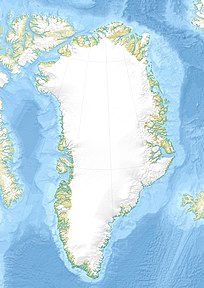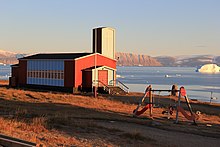Qaanaaq
| Qaanaaq | ||
|---|---|---|
| Thule K'ânâĸ | ||
| Qaanaaq (2007) | ||
| Commune | Avannaata Communia | |
| District | Qaanaaq | |
| Geographical location | 77 ° 29 ′ 0 ″ N , 69 ° 20 ′ 0 ″ W | |
|
|
||
| Residents | 646 (January 1, 2020) |
|
| founding | 1953 | |
| Time zone | UTC − 3 | |
| particularities | northernmost city in the world | |
Qaanaaq [ qaːˈnɑːq ] (according to the old spelling K'ânâĸ ; Inuktun Qaanaaq [ qaːˈnɑː (q) ]; Danish Thule ) is a Greenland city in the district of Qaanaaq in the Avannaata communia .
location
Qaanaaq is located on the southwest coast of the Piulip Nunaa peninsula at the point where the Kangerlussuaq (Inglefield Bredning) becomes Ikersuaq (Hvalsund) when the Murchison Sund branches off . The next inhabited place is Siorapaluk, 49 km to the northwest . Qaanaaq is considered the northernmost city in the world.
history
Qaanaaq was founded in 1953 when the residents of the village Uummannaq applied there Thule Air Base had to give way (Pituffik). Most of the residents were relocated to Qaanaaq. The forced relocation led to a decade-long legal battle with the Danish state , in which Ûssarĸak K'ujaukitsoĸ played an overriding role in enforcing the rights of the Inughuit .
The name Thule was already in the ancient times for a location in the far north of the world mythical island . Knud Rasmussen took up the name at the beginning of the 20th century when he founded a mission and trading station in the previously uncolonialized North Greenland . When the Inughuit were resettled in 1953, Thule was adopted as the Danish name for the newly founded Qaanaaq.
Qaanaaq was the capital of the municipality of Qaanaaq , the northernmost municipality in the country, until 2009 , before it became part of the Qaasuitsup Kommunia as part of the administrative reform , which in turn was split into the Avannaata Kommunia in the north in 2018 .
economy
The main industry in Qaanaaq is hunting, but fishing is to be strengthened in the future. Most of the residents, however, are employed in administration and in trade and crafts. In addition, tourism in Qaanaaq plays a bigger role for adventure tourists, who are shown the traditional life of the Inughuit and can experience the landscape and fauna of the area on boat trips and hikes. Walruses , seals , narwhals , reindeer and various species of birds live around Qaanaaq .
Infrastructure and supply
Qaanaaq Airport , which opened in 2001, is a good four kilometers to the north-west and connects the city to Greenlandic air traffic. A road leads from Qaanaaq to the airport. However, it runs over the numerous glacial streams of the Qaanaaq Glacier and is therefore often flooded when the ice melts . Qaanaaq has an atypically ordered street system made up of several parallel paths, especially in the younger western part of the city. However, the roads in Qaanaaq are in poor condition and unpaved. Most of the traffic in the vicinity is by snowmobiles and dog sleds. Qaanaaq has no port that can be approached directly, which is why the boats are right on the beach.
The state utility company Nukissiorfiit is responsible for the electricity, water and heat supply in Qaanaaq. Electricity is generated by an oil power plant , whose residual heat, together with oil stoves, ensures the heat supply. The water supply is achieved in summer by means of surface water and in winter by melting ice. As in most places in Greenland, there is no sewage network in Qaanaaq. Garbage is dumped west of the city. TELE Greenland guarantees the telecommunication connection of Qaanaaq.
Development
In the school in Qaanaaq, the Avanersuup Atuarfia, around 120 students are taught in grades 1 to 10. The school also includes a library and a school home belongs to it. There is a vocational school, a nursing home and a day nursery. In the city there is also a branch of the Pilersuisoq supermarket chain , which supplies the residents with goods, as well as a handicraft shop housed in the tourist office. For tourism there is also a small hotel, a restaurant and the Qaanaaq museum , which is dedicated to the history of the far north of Greenland and Knud Rasmussen's Thule expeditions . There is also a sports hall, a meeting building, a church and a small hospital in Qaanaaq, as well as a service building with sanitary facilities. There is also an earth magnetic field observatory in Qaanaaq's center.
In December 2018, it was determined that due to improper construction due to the permafrost soil, around 30% of the buildings in Qaanaaq are partially or irreparably damaged and have to be renovated or demolished.
Trivia
Qaanaaq is the subject of Matthias von Guntens documentary ThuleTuvalu from 2015, which deals with the effects of climate change on the Eskimos and the flat islands of Oceania .
Sons and daughters
- Vittus Qujaukitsoq (* 1971), politician (Nunatta Qitornai)
Population development
Despite its remoteness in Greenland, Qaanaaq is one of the fastest growing cities in the country. The population almost doubled between the late 1970s and the late 1990s and has remained relatively the same since then.

Web links
Individual evidence
- ↑ Map with all official place names confirmed by Oqaasileriffik , provided by Asiaq
- ↑ a b c d Qaanaaq at qaasuitsup-kp.cowi.webhouse.dk
- ↑ Qaanaaq in Den Store Danske
- ↑ Husene i Qaanaaq slår revner in the Sermitsiaq
- ↑ Population of Qaanaaq 1977–2020 at bank.stat.gl






